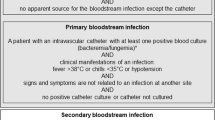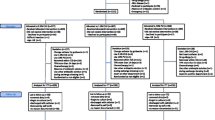Abstract
The aim of this retrospective study was to investigate if the application of chlorhexidine-based solutions (ChloraPrep®) to the exit site and the hub of long-term hemodialysis catheters could prevent catheter-related bacteremia (CRB) and prolong catheter survival when compared with povidone–iodine solutions. There were 20,784 catheter days observed. Povidone–iodine solutions (Betadine®) were used in the first half of the study and ChloraPrep® was used in the second half for all the patients. Both groups received chlorhexidine-impregnated dressings at the exit sites. The use of Chloraprep® significantly decreased the incidence of CRB (1.0 vs 2.2/1,000 catheter days, respectively, P = 0.0415), and hospitalization due to CRB (1.8 days vs 4.1 days/1,000 catheter days, respectively, P = 0.0416). The incidence of exit site infection was similar for the two groups. Both the period of overall catheter survival (207.6 days vs 161.1 days, P = 0.0535) and that of infection-free catheter survival (122.0 days vs 106.9 days, P = 0.1100) tended to be longer for the catheters cleansed with ChloraPrep®, with no statistical significance. In conclusion, chlorhexidine-based solutions are more effective for the prevention of CRB than povidone–iodine solutions. This positive impact cannot be explained by decreased number of exit site infections. This study supports the notion that the catheter hub is the entry site for CRB.


Similar content being viewed by others
References
Hoen B, Paul-Dauphin A, Hestin D, Kessler M (1998) EPIBACDIAL: a multicenter prospective study of risk factors for bacteremia in chronic hemodialysis patients. J Am Soc Nephrol 9:869–876
Onder AM, Chandar J, Coakley S, Abitbol C, Montane B, Zilleruelo G (2006) Predictors and outcome of catheter-related bacteremia in children on chronic hemodialysis. Pediatr Nephrol 21:1452–1458
Powe NR, Jaar B, Furth SL, Hermann J, Briggs W (1999) Septicemia in dialysis patients: incidence, risk factors and prognosis. Kidney Int 55:1081–1090
Onder AM, Chandar J, Saint-Vil M, Lopez-Mitnik G, Abitbol C, Zilleruelo G (2007) Catheter survival and comparison of catheter exchange methods in children on hemodialysis. Pediatr Nephrol 22:1355–1361
Dogra GK, Herson H, Hutchison B, Irish AB, Heath CH, Golledge C, Luxton G, Moody H (2002) Prevention of tunneled hemodialysis catheter related infections using catheter-restricted filling with gentamicin and citrate: a randomized controlled study. J Am Soc Nephrol 13:2133–2139
Klevens RM, Tokars JI, Andrus M (2005) Electronic reporting of infections associated with hemodialysis. Nephrol News Issues 19:37–39
Weijmer MC, Van den Dorpel MA, Van de Ven PJ, Wee PM, van Geelen J, Groeneveld JO, van Jaarsveld BC, Koopmans MG, le Poole CY, Schrander-Van der Meer AM, Siegert CEH, Stas KJF, for the CITRATE Study Group (2005) Randomized, clinical trial comparison of trisodium citrate 30% and heparin as catheter-locking solution in hemodialysis patients. J Am Soc Nephrol 16:2769–2777
Cheesbrough JS, Finch RG, Burden RP (1986) A prospective study of the mechanisms of infection associated with hemodialysis catheters. J Infect Dis 154:579–589
Linares J, Sitges-Serra A, Garau J, Perez JL, Martin R (1985) Pathogenesis of catheter sepsis: a prospective study with quantitative and semiquantitative cultures of catheter hub and segments. J Clin Microbiol 21:357–360
Raad I, Costerton W, Sabharwal, Sacilowski M, Anaissie E, Bodey G (1993) Ultrastructural analysis of indwelling vascular catheters: a quantitative relationship between luminal colonization and duration of placement. J Infect Dis 168:400–407
Safdar N, Maki DG (2004) The pathogenesis of catheter-related bloodstream infection with noncuffed short-term central venous catheters. Intensive Care Med 30:62–67
Pronovost P, Needham D, Berenholtz S, Sinopoli D, Chu H, Cosgrove S, Sexton B, Hyzy R, Welsh R, Roth G, Bander J, Kepros J, Goeschel C (2006) An intervention to decrease catheter-related blood stream infections in the ICU. N Engl J Med 355:2725–2732
Sesso R, Barbosa D, Leme IL, Sader H, Canziani ME, Manfredi S, Draibe S, Pignatari AC (1998) Staphylococcus aureus prophylaxis in hemodialysis patients using central venous catheter: effect of mupirocin ointment. J Am Soc Nephrol 9:1085–1092
Lok CE, Stanley KE, Hux JE, Richardson R, Tobe SW, Conly J (2003) Hemodialysis infection prevention with Polysporin ointment. J Am Soc Nephrol 14:169–179
Segura M, Alvarez-Lerma F, Tellado JM, Jimenez-Ferreres J, Oms L, Rello J, Baro T, Sanchez R, Morera A, Mariscal D, Marrugat J, Sitges-Serra A (1996) A clinical trial on the prevention of catheter-related sepsis using a new hub model. Ann Surg 223:363–369
Luna J, Masdeu G, Perez M, Claramonte R, Forcadell I, Barrachina F, Panisello M (2000) Clinical trial evaluating a new hub device designate to prevent catheter-related sepsis. Eur J Clin Microbiol Infect Dis 19:655–662
Langgartner J, Linde HJ, Lehn N, Reng M, Scholmerich J, Gluck T (2004) Combined skin disinfection with chlorhexidine/propanol and aqueous povidone-iodine reduces bacterial colonization of central venous catheters. Intensive Care Med 30:1081–1088
Bleasdale SC, Trick WE, Gonzalez IM, Lyles RD, Hayden MK, Weinstein RA (2007) Effectiveness of chlorhexidine bathing to reduce catheter-associated bloodstream infections in medical intensive care unit patients. Arch Intern Med 167:2073–2079
Chaiyakunapruk N, Veenstra DL, Lipsky BA, Saint S (2002) Chlorhexidine compared with povidone-iodine solution for vascular catheter-site care: a meta-analysis. Ann Intern Med 136:792–801
Mimoz O, Villeminey S, Ragot S, Dahyot-Fizelier C, Laksiri L, Petitpas F, Debaene B (2007) Chlorhexidine-based antiseptic solution vs alcohol-based povidone-iodine for central venous catheter care. Arch Intern Med 167:2066–2072
Carson SM (2004) Chlorhexidine versus povidone-iodine for central venous catheter site care in children. J Pediatr Nurs 19:74–80
NKF K/DOQI Guidelines. Clinical Practice Guidelines for Vascular Access, 2006 Update. Available at https://doi.org/www.kidney.org
O’Grady NP, Alexander M, Dellinger EP, Gerberding JL, Heard SO, Maki DG, Masur H, McCormick RD, Mermel LA, Pearson ML, Raad II, Randolph A, Weinstein RA; Healthcare Infection Control Practices Advisory Committee (2002) Guidelines for the prevention of intravascular catheter-related infections. Am J Infect Control 30:476–489
Centers for Disease Control and Prevention (2001) Issues in healthcare settings: CDC’s 7 healthcare safety challenges. Atlanta, GA. US Department of Health and Human Services, Centers for Disease Control and Prevention. https://doi.org/www.cdc.gov/ncidod/dhqp/about_challenges.html. Accessed June 28, 2008
Levin A, Mason AJ, Jindal KK, Fong IW, Goldstein MB (1991) Prevention of hemodialysis subclavian vein catheter infections by topical povidone-iodine. Kidney Int 40:934–938
Kessler M, Hoen B, Mayeux D, Hestin D, Fontenaille C (1993) Bacteremia in patients on chronic hemodialysis. A multicenter prospective survey. Nephron 64:95–100
Krein SL, Hofer TP, Kowalski CP, Olmsted RN, Kauffman CA, Forman JH, Banaszak-Holl J, Saint S (2007) Use of central venous catheter-related bloodstream infection prevention practices by US hospitals. Mayo Clin Proc 82:672–678
Smylie HG, Logie JR, Smith G (1973) From Phisohex to Hibiscrub. Br Med J 4:586–589
Mimoz O, Pieroni L, Lawrence C (1996) Prospective, randomized trial of two antiseptic solutions for prevention of central venous or arterial catheter colonization and infection in intensive care unit patients. Crit Care Med 24:1818–1823
Zamora JL, Price MF, Chuang P, Gentry LO (1985) Inhibition of povidone-iodine’s bactericidal activity by common organic substances: an experimental study. Surgery 98:25–29
Lowbury EJ, Lilly HA (1974) The effect of blood on disinfection of surgeons’ hands. Br J Surg 61:19–21
Sticker DJ, Thomas B, Clayton CL (1985) Studies of the genetic basis of chlorhexidine resistance. Br J Clin Prac 25 (Suppl):23–30
Acknowledgments
This study is dedicated to the living memory of Mrs. Cherry Charlton, RN, whose singing voice will always be recalled in the Pediatric Hemodialysis Unit at the University of Miami/Holtz Children’s Hospital.
Author information
Authors and Affiliations
Corresponding author
Rights and permissions
About this article
Cite this article
Onder, A.M., Chandar, J., Billings, A. et al. Chlorhexidine-based antiseptic solutions effectively reduce catheter-related bacteremia. Pediatr Nephrol 24, 1741–1747 (2009). https://doi.org/10.1007/s00467-009-1154-5
Received:
Revised:
Accepted:
Published:
Issue Date:
DOI: https://doi.org/10.1007/s00467-009-1154-5




